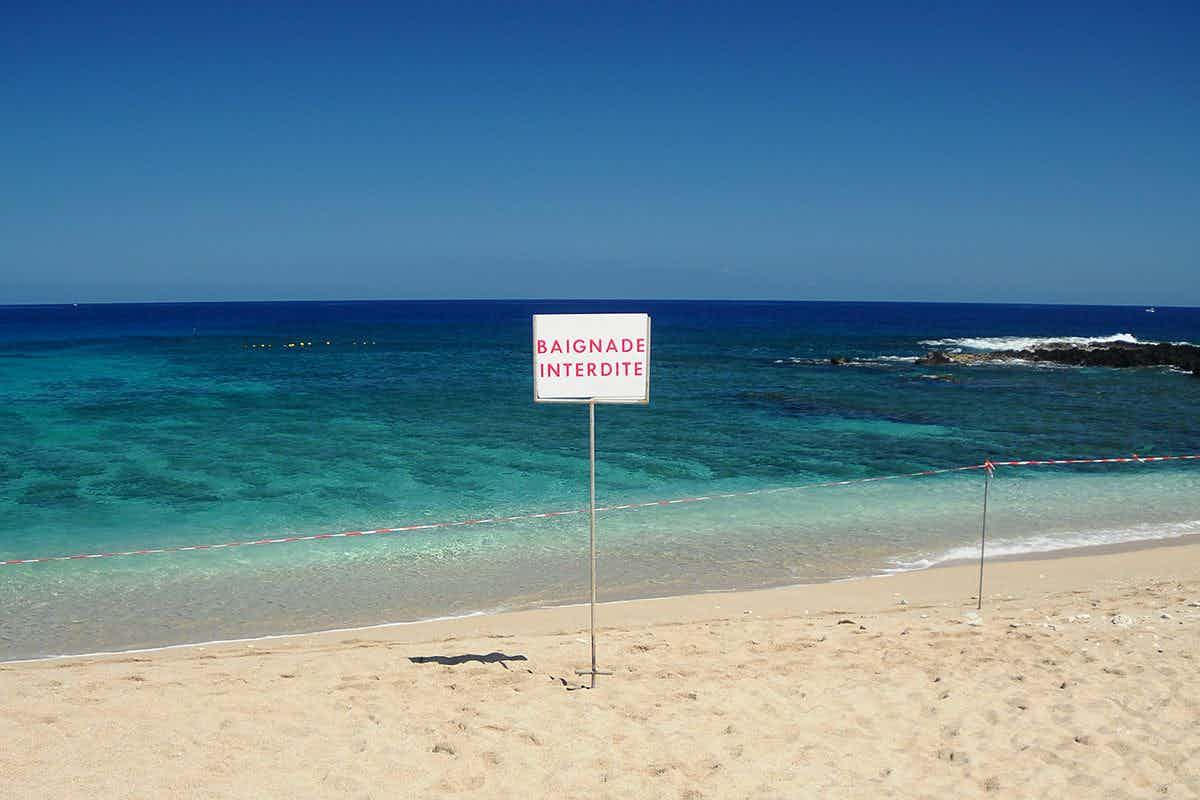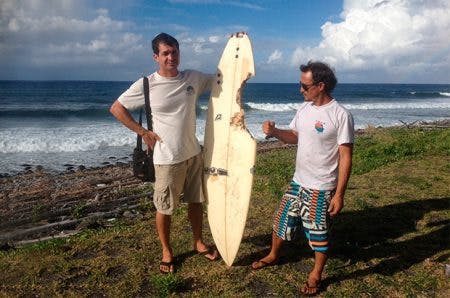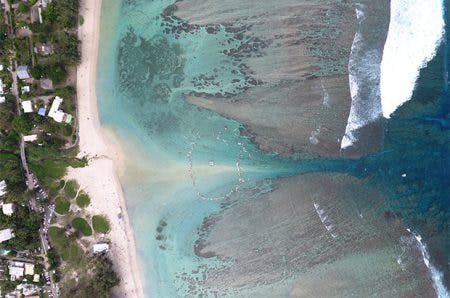Interviews, WildlifeA Reunion of Sharks

For decades, Reunion Island has been known for its high-quality waves in insanely beautiful surroundings and trans-lucid waters. Since 2011 though its reputation has shifted towards being a ‘shark attack hotspot’ more so than ‘wave paradise’, which has led to the shine being taken off the island’s surf spots. The justification for Reunion’s newly acquired status lies in the density of attack rates, which are highlighted when comparing the amount of strikes on humans and the island’s size/population (950 square miles / 850,000 people), that when compared to other more densely populated and larger countries, show a disproportionate ratio of negative interactions between sharks and humans. According to the International Shark Attack File, from 2011 (when the island began to experience an increase in negative shark/human interaction rates) until 2016, Reunion Island was the location for 16% of the world’s fatal shark attacks – 7 out of 43 – the same amount as South Africa, a country that is almost 500 times the size of Reunion and has 70 times more inhabitants. Considering that its low population density adds weight to the label of “shark attack hotspot’, it’s natural that such statistics arouse a valid concern amongst the island’s inhabitants – in particular surfers – and consequently cause something of a burden on their daily lives.
In an attempt to understand the island’s ‘shark situation’ better, Surf Simply approached local surfer, OPR (Ocean Prevention Reunion Association) secretary, and author of ‘Requins à La Réunion -une tragédie moderne-’ (Sharks in Reunion – a modern tragedy-), Jean François Nativel, to get an insider’s take on the matter and find out just how much the shark situation is affecting the lives of the locals and their surfing culture.

When and how did the situation with sharks in Reunion Island turn into a problem?
The situation became abnormal as soon as the first fatal attack occurred on February 19, 2011 on Éric Dargent in Saint Gilles les Bains. Previous to that, the western seaside zone of the island had not experienced any serious attacks in 30 years of development. The shark risk was perfectly known on the island, but remained confined to “wild areas”, renowned for their turbid waters due to our exceptional rainfall. This sudden change in the location of attacks was a strong signal that something had changed: the seaside area had been a kindergarten, where the ocean was shared by many families from morning till evening, without any problem…until 2011.

What were the clearest social changes that happened after the government banned the practice of surfing and water sports outside of the island’s lagoons, in July 2013?
The most important social change has been the strong disapproval of water-sports practitioners, ocean lovers and, in particular, surfers. Since July 2013, the public opinion following each attack is that it’s an individual responsibility, since “it is forbidden”. Many of us see this as the government’s communication strategy: it is enough for the authorities to say “it is forbidden”, so the blame is transferred to the victim, accusing them of being solely responsible since they did not “respect the rule” and thus closing the case. Yet, individual responsibility is only one emerging facet of the iceberg, as there is in our history a veritable scandal with regards to the shark crisis. This provisional ban of 26 July 2013 has been renewed six times and the government doesn’t seem bothered to permanently close the beaches of our island, where tourism remains the main source of income for a population dependent on subsidies and allocations from the French government, half of which live under the poverty line. Bottom line is, our ocean is closed without any prospect of reopening, and we are deprived of any possibility of development, even though we have one of the best concentrations of surf spots in the world. There are more than fifty waves of great quality, very close to shore, easy to access, which work every day, with clear, warm water and good weather almost all the time. Moreover, with the unique situation – compared to many other equivalent islands – of being able to offer a European level of health security in addition to political stability. There are not two similar places on the planet. The future of our island can not be conceived without the revalorization of our coastline.

How has the community of surfers in Reunion Island been responding to the attacks?
Our community responded to the attacks from the beginning by organizing as an association. It must be understood that government authorities can only base decisions on scientific studies – in this case biological – as the problem affects the marine environment. Yet most biologists working on the case of Reunion seem to be engaged in a “blind” conservation of sharks, rather than finding a solution to this issue that is affecting our community directly. The French government has been advised by officials of the Ministry of Ecology and Marine Biologists since the beginning of the crisis, but it has been us, the association, who have carried all the security projects: be it the shark lookouts, the aerial surveillance methods, the sonars, the fishing policy via the program and even the use of drum lines.
After getting organised, we had to show that we were representatives of the population. It was not simple and it was necessary to go through the municipal elections of 2014, which saw 4 elected from our community to deputy responsibilities: Patrick Flores (the father of surfer Jeremy Flores) became deputy for the seaside area; Thierry Martineau (chairman of a large surf club), became sports assistant; Patricia Machado (ex-wife of Rob Machado) became assistant to tourism – all three for the district of Saint-Paul -, Christophe Mulquin (surfing coach), became an assistant to the district of Saint-Leu for water-sport related questions. This legitimacy obtained by the ballot boxes was essential so that our voice – of the ones who live here and are in direct contact with the issue – could be officially heard by the French government.
From a different angle, what position is the government taking on the current situation? If any, are they working?
The French government has taken mostly passive measures with regards to the shark situation in Reunion Island. They spend millions of euros and organise hundreds of meetings – as in Australia or elsewhere – but carefully avoid addressing sensitive issues and assessing the matter actively. The government has launched measures since 2011 without accompanying them with necessary communication to deal with disinformation and propaganda in the form of slander and exaggerations relayed by major media. The protection of sharks has indirectly become a business worth hundreds of millions of euros, not to mention all the geopolitical issues surrounding ocean grabbing: France has 11.2 million square kilometers of ocean, a maritime domain almost equal to the United States’. France has embarked on a shark policy since 2012, and has placed all of French Polynesia and New Caledonia’s waters into a “SHARK sanctuary” (6.1 million square kilometers). At the same time, the shark crisis has arisen in Reunion Island, and we have become a “thorn in the heel” of this global shark policy.
Reunion used to host a series of water-sports events, that with the current highlighted danger of shark attacks have reduced in frequency. How did that change the life of local surfers and watermen? Was there a clear impact in the economy?
The impact on the economy – and consequently our community – is huge. As I said, we are a “wave island” with an exceptional nautical heritage and the inhabitants of Reunion need the ocean for their survival. Those who continue surfing enjoy exceptional waves with hardly anybody in the water, but on the other hand see their friends being victims of attacks and know that tomorrow may be their turn. They constantly oscillate between extreme pleasure and a very real anguish of death. For those who have stopped surfing (like me, since 2012), and who have not been able to leave the island (thousands exiled from Reunion since 2011, to go to France or elsewhere in the world) it is a daily frustration to observe magnificent waves and yet be faced by fines if we enter the water. We try to go around the problem as much as possible by going on holidays, but it costs too much since we are a small, isolated pebble in the middle of the ocean. This has an impact on the economy, since even we (the locals) used to vacation and spend money here in Reunion Island, but now often consider spending it elsewhere. Last but not least is the current image the rest of the world has of the island and its impact on tourism. Everyone who loves water-sports are frightened at the very idea of hearing the name of our island – let along coming here and surfing -, whereas 10 years ago we were the dream destination of thousands of surfers in France and elsewhere in the world.

One of the preventive measures happening at the moment is the ‘underwater lookout method’, invented in Reunion Island. Can you describe the pro’s and con’s of this idea?
It’s already known that to operate the lookouts we need clear waters, with at least 10 m of visibility, and that alone presents a challenge. Plus, it was supposed to be only an experimental and temporary solution for the problem, but remains as the only option applied today. It works solely when the waves are small, because when the swell picks up even the water at our reef breaks gets cloudy, especially since our seabed is littered with sediments of our extreme rainfall. As a result, lookouts only work five days a week, with a time slot of 2 to 6 hours maximum. The lookout groups are limited and the spots where the method has been implemented often offer mediocre waves – except for one, the Hermitage.
This method – like everything that is tested in Reunion – costs a fortune (650 000 € per year) and requires the hiring of more than 30 employees! It is impossible to imagine a sustainable standardization of such method in all of our ‘unsafe’ beaches, and even to think that we can bear such a financial and human work load. In any case, like many other methods, the lookouts will eventually be challenged by the sharks since in a context of proliferation, one day or another there will be an accident. If we have sharks capable of entering an almost closed net, they will be able to pass between the meshes of the surveillance created by this method.

You wrote a book called ‘Requins à La Réunion – une tragédie moderne’ (Sharks in Réunion – a modern tragedy). What was your objective with the book and consequently, what were the outcomes and responses to the publication?
The objective of my book is to give access to the tragic truth we live in Reunion Island at the moment. It aims to restore a more humanitarian view to our specific issue with sharks in the island, since so far only the wild animal seems defensible, which doesn’t seem like the idea of harmonious coexistence. I’m trying to make people realize that we are facing an extremely serious turning point in our modern societies, which in the case of Reunion Island has been dealt with first-hand. The shark crisis is not a shark problem: it is a societal problem. We can no longer “touch” nature and not be seen as villains, even if lives are being lost for a lack of balance in our ecosystem, often caused by us in the first place.
The book I have written is very technical, with many references to studies and data gathered over the years, because the truth of this subject is complex and many aspects need be accountable. I sold about 1,300 books in paper, and am preparing an English version for the end of the year, which will be updated and augmented with picture diagrams to better understand our tragedy.
In researching your book, what were the most interesting facts that you discovered?
My most interesting discovery was a comparative analysis of the six regions most vulnerable to shark attacks in the world. It allows us to understand that our risk in Reunion is unique, and especially linked to the presence of particularly aggressive and determined bull-sharks, and therefore the attack leads much more often to death. An exceptional situation asks for an exceptional response: elsewhere, one can be satisfied with measures of caution, since there are almost never fatal attacks, but here there are no alternatives to “go easy”.
Also based on your research, what’s the real connection between shark attacks and environmental degradation of an area, more specifically in Réunion Island?
There is strictly no link between environmental degradation and shark attacks here on Reunion Island, but it corresponds to a “sweet melody” which people want to hear. There also hasn’t been a correlation between shark attacks and environmental degradation on the planet: many countries in the southern hemisphere experience high levels of pollution and degradation and do not have the means to “treat” their sewage flow that goes directly into the ocean, yet do not experience shark attacks with Reunion’s frequency and proportion. This cliché is so tenacious that I was forced to make a whole publication to try to deconstruct it, which has labelled me as a climate-sceptic, or a “negationist.”
You’re also the secretary of the Ocean Prevention Reunion Association (OPR). Can you tell us what’s the association’s main objective and how it’s being accepted, both by the local community and the government?
The objective of the OPR association was, at the beginning, to contribute to a rapid resolution of the shark crisis. Our observation was simple: there are violent deaths with major social and economic consequences and their causes needs to be addressed sooner rather than later. We naively thought that the problem was going to be settled in six months… and six years later it’s worse than ever. It should be noted that in Europe there has been a rise in the animalism/vegan movement over the last six years, so much so that the protection of bull-sharks and tiger-sharks are among the priorities of the first French political animal party, created in the end of 2016. Now, after six years of pressing, we are recognized as a key player at a local level, but unfortunately this is still insufficient to drive a resolution. Indeed, the debate remains more intense than ever, and local politicians hesitate to take alternative measures, preferring to stay “neutral” rather than engage in action. Yet local people can no longer stand between despair and feelings of revolt. Our “shark crisis” is far from finished and unfortunately all this will end with a lot of opposition, not in the ocean but on land. But we will continue fighting for the dignity of an island that cannot live by being cut off from the ocean.